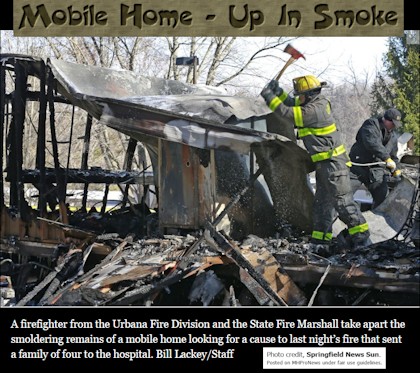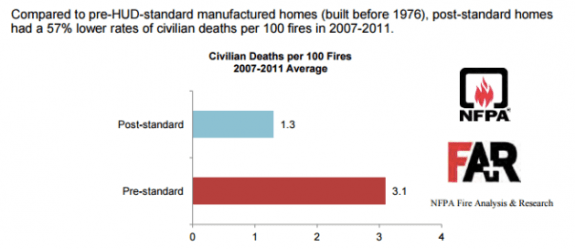
A tragic event in Champaign County, Ohio, on Monday shined a bright light on the differences between mobile and manufactured homes, and why terminology matters.
The mobile home fire left Kalleen Emmons, 23, in critical condition and Robert Garringer, 31, in serious condition. Two children were also injured.
According to the Springfield News-Sun, which did not reply to MHProNews requests for clarification on the type of home involved in the blaze, firefighters were dispatched to the scene Monday at 12:15 a.m. There they discovered the four victims, who had already escaped from the burning home, thanks to a smoke alarm.
The four were transferred by ambulance to Springfield Regional Medical Center.

“This fire involved a true mobile home and was not a manufactured home. I do not have the age of the mobile home available right now,” Urbana Fire Chief Mark Keller told MHProNews.
“Mobile homes are inherently bad with fire conditions. They’re not really designed to withhold any kind of fire.”
Chief Keller said that the home was a total loss and the fire also damaged siding on the home next door.
“Usually once a window is broken out, it spreads very quickly throughout the rest of the trailer [sic]. And that’s pretty much what we had happened.”


Terminology Matters

“As an Industry, we are always saddened to hear of such tragedies such as the fire that occurred in Champaign County,” said Andrea Reichman, Assistant Director of the Ohio Manufactured Homes Association (OMHA).
“As noted by the local Fire Chief Mark Keller, the home involved was a ‘mobile home,’ which indicates the home was built prior to the 1976 HUD Code Federal Manufactured Home Construction and Safety Standards,” Reichman said.
“Often times such incidents are reported inaccurately, and facilitate the image that manufactured homes are not safe when nothing could be further from the truth. Manufactured homes are no more prone to fire than homes built on-site. The 1986 national fire safety study by the Foremost Insurance Company showed that site-built homes are more than twice as likely to experience a fire than manufactured homes,” said Reichman.
About 20 percent of all MH are pre-HUD Code mobile homes, so, the balance would be manufactured homes.
“While many ‘mobile homes’ are replaced every day some still exist. OMHA was encouraged to hear that the home had smoke detectors that were activated during the fire. The industry encourages homeowners to install and test their smoke detectors monthly per the recommendation of the National Fire Protection Association for all residential properties,” she told MHProNews.

As Daily Business News readers are already aware, a “mobile home” has not been built in the U.S. since June 15th 1976, the day the first federally regulated manufactured homes began to the sounds of nail guns and saws in production centers from coast to coast.
National View on the MH Fire Issue

“While any harm to people or property is regrettable, there is no excuse for sloppy journalism that can harm the industry and consumers. The fact is that today’s federally regulated manufactured homes are as safe or safer than other types of homes when it comes to fire, as shown by research done by the National Fire Protection Association on multiple fire safety metrics,” said M. Mark Weiss, JD, President CEO of the Manufactured Housing Association for Regulatory Reform (MHARR).
Weiss’ comments to the Daily Business News raises an important point.
Namely, that “sloppy journalism” can be harmful to the proper image and understanding of manufactured homes. That in turn arguably harms manufactured home owner’s values. Inaccurate media coverage also deters some would-be home buyers of manufactured housing, who might otherwise purchase one; if they realize how safe, appealing, energy-efficient, and affordable contemporary manufactured homes are.
Those lost new and pre-owned MH sales opportunities cost the industry’s businesses money, and workers better-paying job opportunities.
“It is therefore misleading and a disservice to readers to fail to distinguish between pre-1976 ‘mobile homes,’ said Weiss, “and today’s manufactured homes. This is why MHARR successfully demanded several years ago that the U.S. Fire Administration remove similarly misleading language from it’s website.
The industry and consumers need to insist on an accurate media portrayal of today’s high-quality manufactured homes,” said Weiss.
An industry wag told the Daily Business News that it’s inaccurate reporting that should go up in smoke – because compared to other forms of housing – modern manufactured homes more rarely do. Still, prudent precautions such as smoke detectors ought to be followed, along with other safety steps reported in detail at this link here.
For more on the NFPA report on fire safety of modern manufactured home compared to conventional housing and mobile homes, click here. ##
(Image credits are as shown above.)

Submitted by RC Williams to the Daily Business News for MHProNews.
